Third Occipital Nerve


Location
Occipital region of the scalp close to the midline.
Origin
The posterior root of C3, otherwise known as the the Third Occipital Nerve (TON), gives off a medial branch which traces a path between the semispinalis capitis and cervicis muscles, before passing through the splenius capitis and trapezius muscles. Subjacent to the trapezius the medial branch gives off the third occipital nerve.
Course
The third occipital nerve runs as thin fibers vertically, medial to the greater occipital nerve 2, for a short distance, before passing laterally, crossing the greater occipital nerve and running as far as the retroauricular line, where there maybe overlap with small twigs from the lesser occipital nerve. Vertically the fibers do not extend beyond the superior nuchal line.
Branches
There are no named branches of the third occipital nerve, however multiple small twigs intercommunicate with branches of the greater occipital nerve. Far laterally, the branches may overlap with small twigs from the lesser occipital nerve.
Some of the branches transverse medially, across the midline, and intercommunicate with the contralateral third occipital nerve 1.
Supply
The third occipital nerve supplies an area of the medial occipital scalp, overlapping with areas supplied by the greater and lesser occipital nerves.
See Also
References
Part or all of this article or section is derived from Third occipital nerve by Dr Daniel J Bell et al., used under CC BY-NC-SA 3.0

